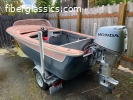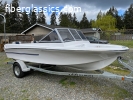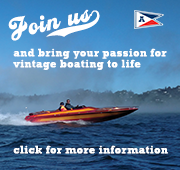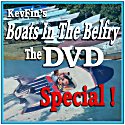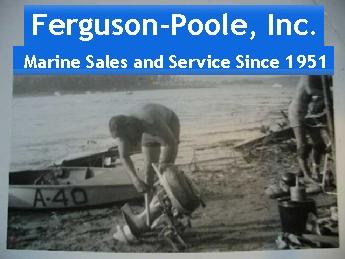As posted on Custom Craft Classic Boats Home Page:
www.nicklecityclassics.com/customcraftboats.htm
Recollections of Henry Donald Canazzi,
Owner and Designer of Custom Craft Boats.
By his son, Craig, and daughter, Kim.
Our father was a vital, competitive and inventive man born in 1917 in Buffalo, New York. He went to Lafayette High School and played basketball for the school team. He loved horses and rode on the trails that once wound around Buffalo starting at the Saddle and Bridal Club built in 1922. He came from modest means but with his enterprising nature, built a unique business in the boating industry eventually becoming the 3rd largest small boat manufacturer in America.
His father, Anthony ‘Pop’ Canazzi, was a tugboat engineer and worked on the construction of the Peace Bridge between Buffalo N.Y. and Fort Erie, Canada in 1925-1927. So our father grew up around boats and developed his ‘water-sense’ on the tricky unpredictable Niagara River.
Before the war, he started a business partnership selling motor yachts and marine accessories to a wealthy cliental in the Buffalo area.
This first venture into the boating business was interrupted with the advent of WW2. He was in the US Navy within a month, stationed in Key West running 73‘ sub-chasers. Here his engineering and design skills were found useful to the Navy for which he created a new motor for use in PT boats, a new surface torpedo, and a new efficient design for a boat bottom.
After contacting malaria in Cuba which necessitated his recall from active duty, he was summoned to Washington where he became well known for his work in the engineering and patent offices.
After the war, Dad returned to Buffalo dissolving his partnership, establishing his own marine retail business. The location on Niagara Street had a gas station, docking and boat storage areas. On the second story of the main building Dad had his offices and oddly enough, a space for selling unfinished furniture! It was from this that he got the idea to start selling plans for boats that people could build themselves. His successful business, in selling the plans and patterns of boats he designed and those of other designers to which he gave royalties, grew into selling packaged boat kits. This part of the business was a success in large part because of the invention of plywood and new innovations in adhesives. Dad always had the vision to incorporate new technology into his projects and designs. He was a pioneer in the mail–order business in plans and patterns, frame kits, hull kits, and boat kit manufacture.
A new factory was needed for all this assembly of precut parts. You could buy anything from a houseboat to a sailboat and receive everything you needed to construct it right down to the nails and even a ships hammer!
Dad always loved to design boats with high performance and speed. He was always reengineering them for the fun and creativity of it. We had a family boat named “The Boo”. It was an old ChrisCraft that he elongated and then installed some formidable inboard motors under what appeared to be seats. We would have family outings on the Niagara River going under the Peace Bridge to Point Abino on the Canadian side. I say family outings but what I really mean is, white knuckle drag races. We would be motoring along and some young guy would come up close to us, rev his motors and take off. Dad would let him get ahead then give “The Boo” full throttle. The motors would roar to life like giant lions leaping after prey and we would leave the poor bewildered challenger behind in our wake.
When fiberglass as a structural material appeared on the market, he began to experiment with it, first in the design of his own cars [see the photo of his Studillac] where he incorporated a massive Cadillac engine within a modified Studebaker body. When he understood all the possibilities of this material, in terms of what it could mean for boating and hull design, this was the real beginning of Custom Craft boats.
Dad took the core of his most talented craftsmen and began another business. Those men named Willi, Henry, Halle, Freddie and Philly, (their last names are lost to us now) we are pleased to mention because without their talented hands in woodworking, and fiberglass molding, he would have been hard put to create the prototypes that he did.
Many patents and innovations came out of those years of work in the late 50’s and throughout the 60’s. The process of creating a fiberglass boat has many stages, the first of which is the design stage. Dad had the vision for a totally modern small craft pleasure boat. He wanted the boat to be smooth riding, fast, maneuverable, and importantly, affordable. He had been designing hulls for some time and had developed innovative ideas to meet those criteria. Heretofore, small pleasure craft were pretty rough riding, poorly appointed, spray in your face, knock-about experiences for the “small boat enthusiast.
By reducing the surface area of the hull, there would be less drag in the water hence more speed. To keep the stability of the boat, he engineered what he called a “tri-step configuration” modeled after the three-point hydroplane. His hulls had a series of molded pontoon-like shapes that ensured stability at higher speeds. He developed multiple deep V hull forms that answered the challenge of creating an amazingly soft ride.
As was stated, the first stage in making a fiberglass boat is the design. For the prototypes, he used wood mockups taking advantage of Willi, Halli and the others. These first test models had to be tried in the water. Many a cold day, Dad and his team were out on the Niagara River with ice chunks floating by and a rescue boat running alongside in case something went wrong.
Next came making the mold from that prototype, and improvements were made at each stage. The hulls had shapes that couldn’t be released out of a simple mold, so Dad invented the split-mold process so that the mold could easily be opened, releasing the fiberglass hull.
Finally came all the other processes that went into making a finished product. He wanted to keep a standard of excellence and innovation every step of the way. For instance, he was the first to introduce aerodynamic wrap-around windshields, replacing the straight stand-up types. He put headlights into the front-end design; he introduced gold flecks into the high gloss custom paint finishes, and his upholstering rivaled anything you could find in boats or cars of the day.
Pleasure boating no longer was just for the elite. Everyone could enjoy boating in these state of the art beautiful boats. At his height, Dad shipped boats all over the world. What he promised in his advertising was true! He provided “the softest, driest ride in boating”…. And “The purchase of a CUSTOM CRAFT boat is and INVESTMENT in LUXURY as well as VALUE.”




